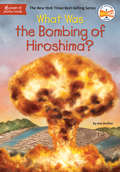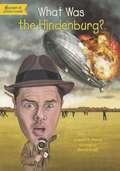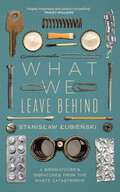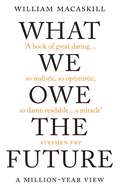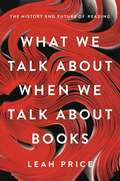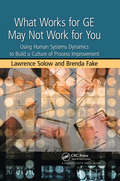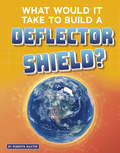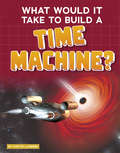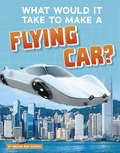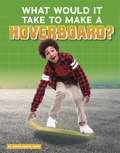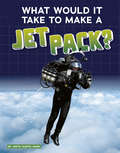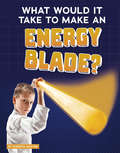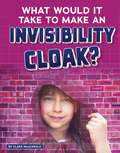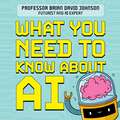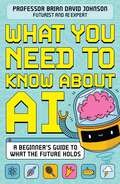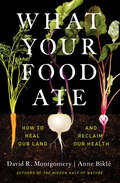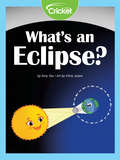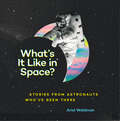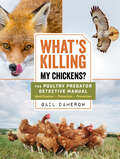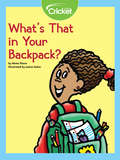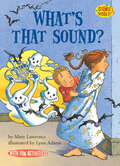- Table View
- List View
What Was the Bombing of Hiroshima? (What Was?)
by Jess Brallier Who HQHiroshima is where the first atomic bomb was dropped. Now readers will learn the reasons why and what it's meant for the world ever since.By August 1945, World War II was over in Europe, but the fighting continued between American forces and the Japanese, who were losing but determined to fight till the bitter end. And so it fell to a new president--Harry S. Truman--to make the fateful decision to drop two atomic bombs--one on Hiroshima and one on Nagasaki--and bring the war to rapid close. Now, even seventy years later, can anyone know if this was the right choice? In a thoughtful account of these history-changing events, Jess Brallier explains the leadup to the bombing, what the terrible results of it were, and how the threat of atomic war has colored world events since.
What Was the Hindenburg?
by Janet Pascal Kevin Mcveigh David GroffAt 800-feet long, the Hindenburg was the largest airship ever built--just slightly smaller than the Titanic! Also of a disastrous end, the zeppelin burst into flame as spectators watched it attempt to land in Lakehurst, New Jersey on May 6, 1937. In under a minute, the Hindenburg was gone, people jumping from windows to escape. However, only 62 of the 97 crew members and passengers onboard survived. The exact cause of the disaster is still unknown and remains a fascinating historical mystery perfect for this series.
What We Become
by Jesse KarpTwo years ago, teenagers Mal and Laura destroyed a corporate empire intent on controlling human thinking through technology. For a while, life was good. But now a new force has arisen: the Old Man. He's hungry for power and he knows who holds the key to getting it: Mal. Mal needs his beloved Laura's help to defeat the Old Man, but is he willing to risk her life in another battle to save humanity? What We Become combines mind-bending thrills with the hot immediacy of corporate greed. It will leave readers wondering who is really in control...
What We Leave Behind: A Birdwatcher's Dispatches from the Waste Catastrophe
by Stanislaw Lubienski"Everything looked perfect. Sand - unique Baltic sand, the best in the world - and the calm sea. But wait. Something was amiss. Something was wrong"It starts with a day at the beach. A single white sock that somehow spoils everything. It's enough to send writer and ornithologist Stanislaw Lubienski on a quest to understand what we throw away, where it goes and whether it will be our legacy. By analysing items he unearths on his trips into nature - a plastic bottle, a tube of Russian penis-enlargement cream, a cigarette butt, an empty aerosol can - tracing their origins and explaining the harm they can do, he shows how consumer society has developed out of control, to the point of environmental catastrophe.He also looks with a birdwatcher's eye at how various animals have come to adapt to and even rely on our rubbish, and interrogates the cultural significance of waste and the origins of our throw-away lifestyles. Finally, he adds a personal touch by examining his own "environmental neurosis" and by going out with refuse crews to watch them work.While Lubienski never hectors his readers, nor shames them, his clear-eyed, persuasive and humble polemic reminds us what we, as individuals, can and cannot do to address an apocalyptic issue while there's still something worth saving.Translated from the Polish by Zosia Krasodomska-Jones
What We Leave Behind: A Birdwatcher's Dispatches from the Waste Catastrophe
by Stanislaw Lubienski"Everything looked perfect. Sand - unique Baltic sand, the best in the world - and the calm sea. But wait. Something was amiss. Something was wrong"It starts with a day at the beach. A single white sock that somehow spoils everything. It's enough to send writer and ornithologist Stanislaw Lubienski on a quest to understand what we throw away, where it goes and whether it will be our legacy. By analysing items he unearths on his trips into nature - a plastic bottle, a tube of Russian penis-enlargement cream, a cigarette butt, an empty aerosol can - tracing their origins and explaining the harm they can do, he shows how consumer society has developed out of control, to the point of environmental catastrophe.He also looks with a birdwatcher's eye at how various animals have come to adapt to and even rely on our rubbish, and interrogates the cultural significance of waste and the origins of our throw-away lifestyles. Finally, he adds a personal touch by examining his own "environmental neurosis" and by going out with refuse crews to watch them work.While Lubienski never hectors his readers, nor shames them, his clear-eyed, persuasive and humble polemic reminds us what we, as individuals, can and cannot do to address an apocalyptic issue while there's still something worth saving.Translated from the Polish by Zosia Krasodomska-Jones
What We Owe The Future: The Sunday Times Bestseller
by William MacAskillThe challenges we face are enormous. But we can still secure a positive future for our planet, and for everyone on it. In What We Owe The Future, philosopher William MacAskill persuasively argues for longtermism, the idea that positively influencing the distant future is a moral priority of our time. It isn&’t enough to mitigate climate change or avert the next pandemic. We can ensure that civilization would rebound if it collapsed; cultivate value pluralism; and prepare for a planet where the most sophisticated beings are digital and not human. 'Unapologetically optimistic and bracingly realistic, this is the most inspiring book on &‘ethical living&’ I&’ve ever read.' Oliver Burkeman, Guardian &‘A monumental event.' Rutger Bregman, author of Humankind &‘A book of great daring, clarity, insight and imagination. To be simultaneously so realistic and so optimistic, and always so damn readable… well that is a miracle for which he should be greatly applauded.&’ Stephen Fry
What We Talk About When We Talk About Books: The History and Future of Reading
by Leah PriceReports of the death of reading are greatly exaggeratedDo you worry that you've lost patience for anything longer than a tweet? If so, you're not alone. <P><P>Digital-age pundits warn that as our appetite for books dwindles, so too do the virtues in which printed, bound objects once trained us: the willpower to focus on a sustained argument, the curiosity to look beyond the day's news, the willingness to be alone. <P><P>The shelves of the world's great libraries, though, tell a more complicated story. <P><P> Examining the wear and tear on the books that they contain, English professor Leah Price finds scant evidence that a golden age of reading ever existed. From the dawn of mass literacy to the invention of the paperback, most readers already skimmed and multitasked. <P><P>Print-era doctors even forbade the very same silent absorption now recommended as a cure for electronic addictions. The evidence that books are dying proves even scarcer. <P><P>In encounters with librarians, booksellers and activists who are reinventing old ways of reading, Price offers fresh hope to bibliophiles and literature lovers alike.
What Works for GE May Not Work for You: Using Human Systems Dynamics to Build a Culture of Process Improvement
by Lawrence Solow Brenda FakeWhat Works for GE May Not Work for You: Using Human Systems Dynamics to Build a Culture of Process Improvement provides new tools for managing and sustaining process improvement in today‘s complex non-linear environments and helps readers apply new, relevant theory to their own management practices. With more than 50 combined years of change manage
What Would It Take to Build a Deflector Shield? (Sci-Fi Tech)
by Roberta BaxterIn science fiction, deflector shields protect ships, bases, and even planets from enemy attack. How could a protective space that absorbs energy from weapons be created? Scientists have some ideas, which include using lasers. Discover the science and technology behind what it would take to make a real-life deflector shield!
What Would It Take to Build a Time Machine? (Sci-Fi Tech)
by Yvette LaPierreIn science fiction, time machines let people travel backward in history and forward to the future. How could one of these time-traveling devices be created? Scientists have some ideas, which include using spaceships and black holes. Discover the science and technology behind what it would take to make a real-life time machine!
What Would It Take to Make a Flying Car? (Sci-Fi Tech)
by Megan Ray DurkinIn science fiction, flying cars let people soar over traffic jams and get to where they're going quickly. How could a vehicle that both flies and drives be created? Scientists' ideas for this involve futuristic materials and technology from drones. Discover the science and technology behind what it would take to make a real-life flying car!
What Would It Take to Make a Hoverboard? (Sci-Fi Tech)
by Anita Nahta AminIn science fiction, hoverboard users glide above sidewalks on machines that look like skateboards with no wheels. How could one of these floating boards be created? Scientists have some ideas, which include using powerful magnets. Discover the science and technology behind what it would take to make a real-life hoverboard!
What Would It Take to Make a Jet Pack? (Sci-Fi Tech)
by Anita Nahta AminIn science fiction, jet packs let people zoom through the air at high speeds. Discover the science and technology behind what it would take to make a real-life jet pack!
What Would It Take to Make an Energy Blade? (Sci-Fi Tech)
by Roberta BaxterIn science fiction, energy blades are weapons or tools that look like glowing swords. How could one of these powerful devices work? Scientists have some ideas, which include using plasma. Discover the science and technology behind what it would take to make a real-life energy blade!
What Would It Take to Make an Invisibility Cloak? (Sci-Fi Tech)
by Clara MacCaraldIn science fiction, invisibility cloaks let their users vanish from sight and sneak around unnoticed. How could one of these stealthy pieces of clothing work? Scientists have some ideas, which involve bending light. Discover the science and technology behind what it would take to make a real-life invisibility cloak!
What Would It Take to Upload a Mind? (Sci-Fi Tech)
by Megan Ray DurkinIn science fiction, people upload their minds into computers for them to be stored. How could this futuristic way of preserving the mind work? Scientists have some ideas, which involve mapping the brain cell by cell. Discover the science and technology behind what it would take to upload a mind in real life!
What You Need to Know About AI: A beginner’s guide to what the future holds
by Brian David JohnsonThe only book you need on AI - for all curious, fact-gobbling kids age 7+.What actually is AI? Will it take over the world? And one day, will it tidy your bedroom...? In this beginner's guide, learn everything you need to know about AI, from how it helps us discover epic stuff up in space or under the sea, whether it will help you build your very own dinosaur, and why, it won't actually help you write your homework! Written by AI expert and Futurist, Brian David Johnson, you will learn what AI is, where it came from, and how it's already being used in the world of sport, space, medicine, animals and more. You will discover AI's amazing possibilities that might shape the future. And along the way, you'll learn super cool facts, bust some myths, and gain a balanced and informed view on the biggest topic of our time.Designed with fun line illustrations throughout.
What You Need to Know About AI: A beginner’s guide to what the future holds
by Brian David JohnsonThe only book you need on AI - for all curious, fact-gobbling kids.What actually is AI? Will it take over the world? And one day, will it tidy your bedroom . . .? In this beginner's guide, learn everything you need to know about AI, from how it helps us discover epic stuff up in space or under the sea to whether it might help you build your own dinosaur.With AI expert and futurist Brian David Johnson, discover what AI is, where it came from, the incredible ways it's being used today and how it might shape and reimagine your future. Learn that AI is just software and that it won't replace human creativity or imagination, but it could help us do some really cool things. And uncover amazing facts, myth busters and insight from experts around the world!This book offers a balanced, expert and fascinating view on the biggest topic of our time. Designed with fun illustrations throughout.
What Your Food Ate: How to Heal Our Land and Reclaim Our Health
by David R. Montgomery Anne BikléAre you really what you eat? David R. Montgomery and Anne Biklé take us far beyond the well-worn adage to deliver a new truth: the roots of good health start on farms. What Your Food Ate marshals evidence from recent and forgotten science to illustrate how the health of the soil ripples through to that of crops, livestock, and ultimately us. The long-running partnerships through which crops and soil life nourish one another suffuse plant and animal foods in the human diet with an array of compounds and nutrients our bodies need to protect us from pathogens and chronic ailments. Unfortunately, conventional agricultural practices unravel these vital partnerships and thereby undercut our well-being. Can farmers and ranchers produce enough nutrient-dense food to feed us all? Can we have quality and quantity? With their trademark thoroughness and knack for integrating information across numerous scientific fields, Montgomery and Biklé chart the way forward. Navigating discoveries and epiphanies about the world beneath our feet, they reveal why regenerative farming practices hold the key to healing sick soil and untapped potential for improving human health. Humanity’s hallmark endeavors of agriculture and medicine emerged from our understanding of the natural world—and still depend on it. Montgomery and Biklé eloquently update this fundamental reality and show us why what’s good for the land is good for us, too. What Your Food Ate is a must-read for farmers, eaters, chefs, doctors, and anyone concerned with reversing the modern epidemic of chronic diseases and mitigating climate change.
What's an Eclipse
by Chris Jones Amy TaoHow can the moon or sun seem to disappear right before our eyes? When the moon, the Earth, and the sun align just right in their orbits, they can cause a solar or lunar eclipse! Find out how light and shadow work together to trigger these cool events.
What's It Like in Space?: Stories from Astronauts Who've Been There
by Ariel WaldmanBlast off and experience space travel with this collection of fascinating, funny, and sometimes weird anecdotes from real astronauts.Everyone wonders what it’s really like in space, but very few of us have ever had the chance to experience it firsthand. This captivating illustrated collection brings together stories from dozens of international astronauts—men and women who’ve actually been there—who have returned with accounts of the sometimes weird, often funny, and awe-inspiring sensations and realities of being in space. With playful artwork accompanying each, here are the real stories behind backwards dreams, “moon face,” the tricks of sleeping in zero gravity and aiming your sneeze during a spacewalk, the importance of packing hot sauce, and dozens of other cosmic quirks and amazements that come with travel in and beyond low Earth orbit.Praise for What’s It Like in Space?“Houston, we have a winner.” —Oprah Magazine“[A] captivating illustrated collection.” —Smithsonian Magazine“A delightful mini-coffee table book about all the awkward and beautiful moments you can have in space, based on dozens of interviews with people who have actually been there. If you’re looking for a fun read about life outside the gravity well, check out What’s It Like in Space?” —Ars Technica“This charmingly illustrated book is much meatier than its diminutive size would suggest. These snippets are so clear, so beautifully curated, that they really do leave you with a sense of what it must be like to float miles above Earth.” —Entertainment Weekly
What's Killing My Chickens?: The Poultry Predator Detective Manual
by Gail DamerowFor backyard chicken keepers and large-scale farmers alike, the single greatest challenge is protecting poultry from predators. What&’s Killing My Chickens? is the essential guide to identifying the culprit and ensuring safety for the flock. Often, by the time an attack is discovered, the predator has already left the scene. Best-selling author and chicken expert Gail Damerow uses the style of a detective manual to teach readers how to follow clues such as tracks, trails, scat, and other signs to identify the attacker. Predator profiles describe key habits of each one and best techniques for blocking their access to the coop and yard, including removing attractants, using poultry guardians and lighting, and installing the most effective type of fencing. This empowering book offers essential knowledge, and peace of mind, for every chicken keeper. This publication conforms to the EPUB Accessibility specification at WCAG 2.0 Level AA.
What's That in Your Backpack?
by Mona PeaseAre you carrying a forest on your back? Of course not! But if you dig through your backpack, you will probably find many things that come from the forest.
What's That Sound? (Science Solves It!)
by Mary LawrenceSolve kid-sized dilemmas and mysteries with the Science Solves It! series. These fun books for kids ages 5–8 blend clever stories with real-life science. Why did the dog turn green? Can you control a hiccup? Is that a UFO? Find the answers to these questions and more as kid characters dive into physical, life, and earth sciences. Two weeks in the country—it&’s the perfect summer getaway for Amy and Tim&’s family. But the house looks haunted, and they hear spooky sounds everywhere. Creaks and squeaks, rattles and rumbles. Could Amy and Tim be sharing their summer spot with a ghost? Books in this perfect STEM series will help kids think like scientists and get ahead in the classroom. Activities and experiments are included in every book! (Level One; Science topic: Sound)
What's the Matter?: A Physical Science Unit for High-Ability Learners in Grades 2-3
by Clg Of William And Mary/Ctr Gift EdWhat's the Matter? is a field-tested physical science unit for high-ability learners in grades 2-3. In this unit, students work on solving real-world scenarios by using their newly discovered knowledge of matter, the measurement of matter, and change in physical properties. At the end of this 15-lesson unit, students present their data in a classroom “science conference.”What's the Matter?, a Project Clarion Primary Science Unit, utilizes a hands-on, constructivist approach that allows children to build their knowledge base and skills while they explore science topics through play and planned investigations. The overarching concept of change is used to deepen understanding of the scientific concepts in the unit.Winner of the 2010 NAGC Curriculum Studies Award, What's the Matter? was developed by the Center for Gifted Education at The College of William and Mary, to offer advanced curriculum supported by years of research. The Center's materials have received national recognition from the United States Department of Education and the National Association for Gifted Children, and they are widely used both nationally and internationally.Each of the books in this series offers curriculum that focuses on advanced content and higher level processes. The science units contain simulations of real-world problems, and students experience the work of real science by using data-handling skills, analyzing information, and evaluating results. The mathematics units provide sophisticated ideas and concepts, challenging extensions, higher order thinking skills, and opportunities for student exploration based on interest. These materials are a must for any teacher seeking to challenge and engage learners and increase achievement.Grades 2-3
